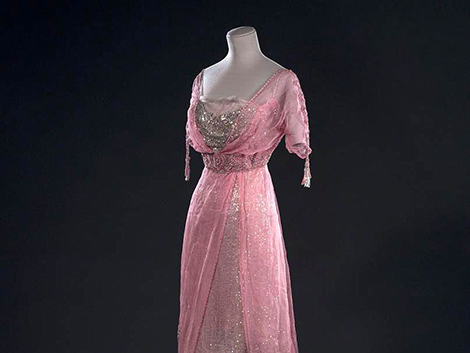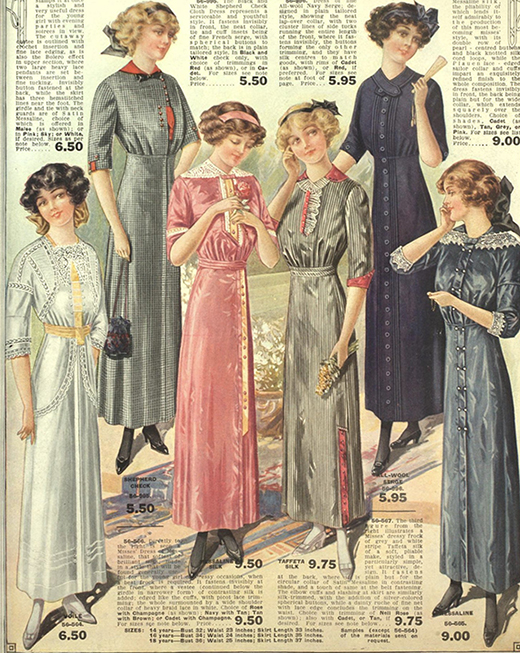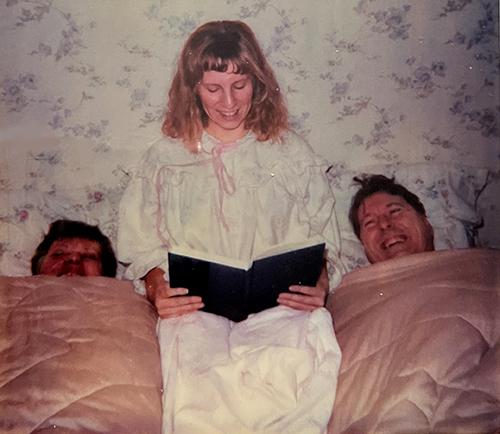
Jessie’s Pink Party Dress
By Lynne Golding
In The Mending, Jessie and her 16 year old friends are excited to attend a Valentine’s Day dance in the gymnasium of the newly reconstructed Brampton High School—its predecessor having burned to the ground in 1917. One friend, Marion, wore a dress new to her that once belonged to an older sister. Two other friends, Frances and Margaret, had new red dresses for the occasion, each red. Jessie was attired in her well-worn pink chiffon dress, with its high square neckline and long skirt and sleeves. It was the same dress she had worn to every dance in the prior fifteen months.
Jessie’s dress was entirely of my imagination. In working on this newsletter, I wondered whether it was realistic. Would the real Jessie have worn a pink chiffon dress in 1919? Would she have worn a pink dress anywhere? What about women a decade earlier? Would a Canadian woman in 1909 have possessed pink attire?
Women’s Gowns in 1919
Colleen and I looked at a few sources to answer these questions: the Toronto Star, the Globe and Mail and the catalogues of Eaton’s, then Canada’s largest retailer. The newspapers were particularly helpful since in both periods of time publishers devoted many printed columns to descriptions of society events and the attire of their guests. We see some of this in newspapers today: pictures of high profile couples at leading charity galas. But today’s articles pale in comparison to the reports of a century ago, where at a ball attended by 500 people, the names of over one-third of the women would be reported and their dress described.
As an example, the Toronto Star described a 1909 charity Bal Poudre (powdered wig ball) at the King Edward Hotel. There were 500 people in attendance, presumably half of them women. Of the 250 or so women in attendance the dresses of 93 were described with at least one sentence, indicating at a minimum the colour of their dress. Twenty were wearing pink. A rugby dance held at the University of Toronto the same night and had similar reports of many women wearing pink.
The same is true of reporting in 1919 where pink continued to be a popular colour at society events. One big difference between the two decades relates to the description of the male attire. There was relatively little reporting on it in either decade but in 1919 the most popular dress wear for men at society events was the military uniform.
In answer to the first question then, we can provide an emphatic yes! Dressing Jessie in that pink chiffon gown in 1919 was realistic. Chiffon was very popular as a fancy dress fabric and pink was a popular colour. While the dress the fictional Jessie wore was merely chiffon (with a special red sash for the Valentine’s Day dance), it could have been embellished with embroidery, beads or trims to fit in with the times. One advertisement for chiffon fabric described it like this:
“Daintiest of all, however, are chiffons in beaded effects. The chiffon is beaded all over and finished with the daintiest of coloured borders. Colours are white with pink or white with gold.”
Other types of fabric and colours were also popular for dances in 1919 including velvet; silk; taffeta; georgette crepe (translucent woven silk with a slightly puckered); satin; crepe de chine (a processed fabric with a texturized matte finish surface providing “chromatic depth”); and charmeuse (a satin and silk weave with a high gloss finish on one side and a dull finish on the other side).
One other aspect of Jessie’s fictional dress holds true: the fact that she only had one fancy dress and wore it repeatedly. Her dress may have once belonged to her older sister, Ina. In 1920, Eaton’s was advertising youthful frocks to be worn at fancy dinners or dances for prices of between $75 to $200. At that time, a year of tuition at the University of Toronto was $40.

Day Dresses
And what of clothing outside of the dance hall? Would day dresses be available in pink? In 1919 the answer is a resounding yes. Hats, shoes, lingerie of all sorts, handkerchiefs, gloves, etc. all were available in pink, including ready-made (pre-made) day dresses.
In this, however there is a difference from the situation in 1909 where there were few ready-made pink day dresses on offer. While pink fabric was available for purchase by the yard for custom made dresses (in satin, broadcloth and wool), it seems that retailers like Eaton’s were not confident enough in the likelihood of sales to include many pink day dresses among their ready-made black, tan and cadet (what we would call teal) offerings. The difference may be accounted for in the post-war mood of 1919, and the desire of all those who had survived the war’s ravages for a lighter, gayer existence, the mood that ushered in the roaring twenties.

Underclothes
While Canadian girls and women may not have worn many pink day dresses in 1909, pink was not absent from their garments, particularly their undergarments and nightwear.
Indeed the most ready-made pink gowns sold by Eaton’s, were those made of flannelette. In October 1910, Eaton’s was promoting flannelette night gowns, either plain or stripped, with varying yokes, numbers of tucks and types of trims and frills (lace or silk).
Also available in pink flannelette in 1910 were corsets covers (which appear to be like our t-shirts), drawers (finished with elastic at the knee) and skirts (which appear to have been worn under a dress or other skirt). Bloomers however, though of extra fine quality, were only available in black.
My favourite, both in description and nostalgic comfort was the advertised “Mother Hubbard” style nightgown which obviously held its appeal for decades to come, at least in certain quarters.

I now know why my mother referred to me as Mother Hubbard when I padded downstairs for hot porridge on cold winter mornings.


To Order Your Copies
of Lynne Golding's Beneath the Alders Series

